
Vibration isolators minimize vibration and noise between equipment or structures, preventing damage during operation or natural disasters. They are widely used in industries such as transportation, aerospace, defense, manufacturing, electronics, and medical sectors. Market growth is driven by strict noise and vibration regulations in Europe, fire safety and sustainability concerns in North America, and rising investments in industrial, maritime, and construction projects.
This study gives a detailed analysis of drivers, restrains, opportunities and challenges limiting the market expansion of Vibration Isolator market. The survey included a diverse set of players, including a balance of leading and growing manufacturers for business profiling, such as;
EB RUBBER METAL PRODUCTS PVT, LTD IAC Acoustics Trelleborg AV Industrial Products Ltd Fibet Rubber Bonding (UK) Ltd. Flexico Anti-Vibration Methods (Rubber) Co Ltd Karman Rubber Company GMT Rubber VibraSystems Inc. Aplicaciones Mecánicas del Caucho S.A Isotech, Inc. Minus K Technology Newport Corporation Parker Hannifin Corp. (LORD)
Our expert team is consistently working on updated data and information on the key player's related business processes that value the market for future strategies and predictions
Get Access to a Free Copy of Our Latest Sample Report - https://www.sphericalinsights.com/request-sample/1028
Market Segmentation:
By Type
- Elastomeric
- Mechanical
- Air Isolators Mounts
- Compact Pneumatic Isolator
- Others
By Application
- Architecture
- Transportation
- Aerospace and Defense
- Electronics
- Industrial
- Manufacturing
- Medical
- Others
Covered in this Report:
1. Go-to-market Strategy.
2. Neutral perspective on the market performance.
3. Development trends, competitive landscape analysis, supply side analysis, demand side analysis, year-on-year growth, competitive benchmarking, vendor identification, QMI quadrant, and other significant analysis, as well as development status.
4. Customized regional/country reports as per request and country level analysis.
5. Potential niche segments and regions exhibiting promising growth covered.
6.Analysis of Market Size (historical and forecast), Total Addressable Market (TAM), Serviceable Available Market (SAM), Serviceable Obtainable Market (SOM), Market Growth, Technological Trends, Market Share, Market Dynamics, Competitive Landscape and Major Players (Innovators, Start-ups, Laggard, and Pioneer).
Buy this report now:- https://www.sphericalinsights.com/checkout/1028
Industry Developments:
May 2020, Minus K Technology had launched the Negative-Stiffness vibration isolation platform – the ultra-thin, low-height model CT-2 passive isolator at just 2-1/2 inches in height, delivering 1/2 Hz vertical natural frequency, and 1-1/2 Hz horizontal natural frequency considerably more low-frequency vibration isolation performance compared to air tables and active systems.
Regional Analysis for Vibration Isolator Market:
✫ North America: (U.S., Canada, Mexico)
✫ Europe: (U.K., Italy, Germany, Russia, France, Spain, The Netherlands and Rest of Europe)
✫ Asia-Pacific: (India, Japan, China, South Korea, Australia, Indonesia Rest of Asia Pacific)
✫ South America: (Colombia, Brazil, Argentina, Rest of South America)
✫ Middle East Africa: (Saudi Arabia, U.A.E., South Africa, Rest of Middle East Africa)
Benefits of the Report:
⏩ A descriptive analysis of demand-supply gap, market size estimation, SWOT analysis, PESTEL Analysis and forecast in the global market.
⏩ Top-down and bottom-up approach for regional analysis
⏩ Porter’s five forces model gives an in-depth analysis of buyers and suppliers, threats of new entrants substitutes and competition amongst the key market players.
⏩ By understanding the value chain analysis, the stakeholders can get a clear and detailed picture of this Market
Insightful inquiry before buying:- https://www.sphericalinsights.com/inquiry-before-buying/1028
Frequently asked questions:
➥ What is the market size of the Vibration Isolator market?
➥ What is the market growth rate of the Vibration Isolator market?
➥ What are the Vibration Isolator market opportunities and threats faced by the vendors in the global Vibration Isolator Industry?
➥ Which application/end-user or product type may seek incremental growth prospects? What is the market share of each type and application?
➥ What focused approach and constraints are holding the Vibration Isolator market?
➥ What are the different sales, marketing, and distribution channels in the global industry?
Unlock the full report now! @ https://www.sphericalinsights.com/reports/vibration-isolator-market
Related URLs:
- https://www.sphericalinsights.com/reports/cruise-ships-tourism-market
- https://www.sphericalinsights.com/reports/cotton-towel-market
- https://www.sphericalinsights.com/reports/us-uk-aerospace-and-defense-pcb-market
- https://www.sphericalinsights.com/reports/asia-pacific-rooftop-solar-market
- https://www.sphericalinsights.com/reports/aircraft-fairings-market
- https://www.sphericalinsights.com/reports/commercial-water-treatment-market
- https://www.sphericalinsights.com/reports/u-s-commercial-water-treatment-system-market
- https://www.sphericalinsights.com/reports/veterinary-imaging-market
- https://www.sphericalinsights.com/reports/data-lake-market
- https://www.sphericalinsights.com/reports/north-america-automotive-plastics-exterior-trim-market
About the Spherical Insights
Spherical Insights is a market research and consulting firm which provides actionable market research study, quantitative forecasting and trends analysis provides forward-looking insight especially designed for decision makers and aids ROI.
which is catering to different industry such as financial sectors, industrial sectors, government organizations, universities, non-profits and corporations. The company's mission is to work with businesses to achieve business objectives and maintain strategic improvements.
Contact Us:
Company Name: Spherical Insights
Email: sales@sphericalinsights.com
Phone: +1 303 800 4326 (US)











